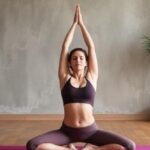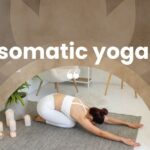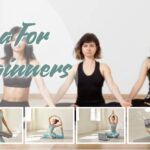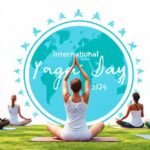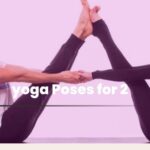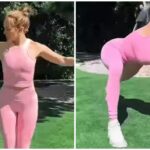Want to lose weight with yoga? These 15 effective yoga asanas will help you slim down, tone up, and feel amazing—no gym required.
Best Yoga Poses For Weight Loss
1. Simhasana

It is a unique posture, known as Simhasana or the Lion Pose. Simhasana has an unusual breath sound that sounds like a roar and has specific facial expressions known as exercise for pranayama, facial muscles, and throat exercises. Benefits of Simhasana are as follows:
Steps to Perform Simhasana:
Initial Position: With your buttocks on your heels, both knees together, sit in vajrasana or so-called Thunderbolt Pose.
Extend your fingers as wide as you can, and place your palms on your thighs.
Hands Position: Lean forwards slightly and place hands near the knees, or simply allow them to stay in place.
Keep your arms straight and fingers toward your body.
Activate Your Face Muscles:
Inhale air fully through the nose.
Stretch both lips outside, put forth your tongue as much you can, and then bring down near your chin without touching the floor.
The volume of the ha sound made through the mouth should be comparatively loud, resembling a roar made by the lion.
Visualize and Concentrate:
While exhaling, keep the vision focused over the nose tip or between the eyebrows in the middle.
Postpone the breath for a moment and release fully.
Come back from this and repeat the exercise:
With the movement back to the original setup, compose a close mouth and relaxed facial muscles.
Perform this two to three times.
Advantages of Simhasana
Activation of Vibration in the Throat and Respiratory System:
Improves the flow of air through the respiratory system and is curative in throat problems.
Empower Muscles of the Face:
World of face stretches and tones the facial muscles thereby maintaining youthfulness and preventing wrinkles.
Decreases Stress and Anxiety:
Leads to elimination of pent-up stress and tension by a deep breath and a roar-like exhale thus helping one to relax.
Improves Circulatory Flow:
This helps improve blood circulation in the neck and face, thus delivering good blood supply to the skin, thereby promoting a brilliant healthy look.
Relieves Tension from the Face and Chest Area:
like those who clench their jaws or grind their teeth, it helps them by releasing tension in the facial and chest muscle.
Push Self-confidence:
Simhasana exhale strong inspires self-assurance and self-confidence.
2. Jalandhara Bandha

Most people know it as a “Chin lock” but it has a different word. Jalandhara Bandha: Bandha or energy locks is one of the three locks widely used in yogic practices. This is normally coupled with meditation and pranayama, or breathing techniques. These are the benefits when performing Jalandhara Bandha asanas:
How to Do Jalandhara Bandha
Take a Comfortable Seating Position: Any sitting posture like Vajrasana or Thunderbolt Pose as well as Padmasana or Lotus Pose, and Sukhasana or Easy Pose-so named as it is very simple-should also establish a straight spine and relaxed shoulders.
Inhale deeply. Breathe in through your nose deeply.
Lower the Chin: Slowly reach your chin down to rest between your collarbones (sternum) as you hold your breath. Make sure your back remains straight.
Lift the Sternum: For a great lock, lift your chest marginally above as you lower your chin.
Hold Posture: As long as you can hold your breath comfortably, hold the posture. The spine should be kept as straight as possible and the lock should remain in place.
Release: Now you can return your head to a normal posture as you exhale softly to release the bandha.
Jalandhara Bandha Advantages:
It controls the Thyroid Gland, that is, the parathyroid and the thyroid glands, which are very important for calcium balance and body metabolism, are stimulated and regulated by this lock-in bandha.
Improves the Breathing Quality: By improving the inflow and outflow of air into and from the lungs, it increases the efficiency of the respiratory system.
Peace of Mind: Inward calm and watchfulness is induced by this bandha, thereby bringing peace of mind by lowering stress and anxiety.
Energy Balance: It takes part in the general harmony and stability of life processes within the body, particularly when it draws prana or life energy into it, directing it to flow inside the body, because it serves as a way to assist in energy balancing.
Be cautious:
This practice is not advisable for those with neck issues, high blood pressure, or heart conditions or has to be done under a certified yoga instructor’s supervision.
Empty the belly: Practice half and full throat locks before doing the exercises several hours after your last meal or if the stomach is empty.
Adhere to Breakdown: Newcomers should adopt a brief stretch session and eventually let themselves become more accustomed to the routine.
3. Adho Mukha Svanasana

The naked diviner or Chaturanga Dandasana’s simply essential for a number of types of yoga. Like in Ashtanga and Vinyasa styles, this is a very intense stance that pretty much tones the back as well as the muscles of shoulders, arms, and core.
4. Here’s How to Do Dandasana Chaturanga:

Begin in Plank Pose: Set your hands shoulder-width apart and align the body so the head, heels, and torso form a straight line.
Engage Your Core:
Draw the belly button back toward the spine to fire up the core muscles. Stable and protect the small of the back.
Lower Down: Slowly bend your elbows to guide your body towards the floor. For an angle of 90 degrees, arms must parallel each other, and elbows keep in contact with the ribs. The whole body should maintain its alignment line from head to heels.
Maintain the Position:
Prevent your shoulders from dropping below your elbows while you hold it for a few breaths. Slightly forward-looking and the chest lifted.
Release:
Finish by letting the entire body touch the ground or by doing Cobra (Bhujangasana) or Upward Facing Dog (Urdhva Mukha Svanasana).
Benefits:
strengthens muscles in the arms, shoulders, wrists, and core.
aids with posture and alignment.
makes the whole body strong and stable.
helps the body prepare for transitioning into more complex postures and transitions during yoga.
Tips:
Make sure that your body remains in a straight line the entire time you hold the pose so as not to strain your lower back.
Use your triceps for the most effective and proper action of the shoulder muscles.
Especially train for a farther apart and more single stack of power and stamina in the position.
If you find it challenging to perform, you may eventually take your knees to the floor to get the pose right.
Most Common Mistakes:
An overly high or low lift of the hips might cause.
5. Ardha Pincha Mayurasana

To conduct the Ardha Pincha Mayurasana, the individual will be asked to get into a level and upright position. On the knees and hands, it is like putting yourself on a table with your knees falling below your hips and your wrists beneath your shoulders.
For the elbow positions: -As you lower your forearms to the mat, ensure that your elbows are shoulder-width apart.
-Interlace your fingers or keep your hands flat on the mat-fit to what’s more comfortable.
Set Core to Work:
Lift knees off the mat by curling toes underneath.
Lift hips way up high into the air and extend through both legs.
Shape the legs and spine in the form of an inverted “V” with your body holding the position and breath; the position is similar to Downward Dog, but with forearms on the mat.
From this position, lengthen back and then exhale:
Apply equal pressure both with your tip of the hands as well as the forearms.
During the pose, refrain from letting the head hang between the arms.
Bring your shoulder blades down your back and activate your core.
Deep exhale and feel the stretch through the legs and back.
Maintain posture for a few breaths or as long as it feels comfortable.
During the entire duration, keep your focus on the alignment and breath.
Release from the pose:
Come back to the table top letting your knees come back to the mat slowly to finish off the pose.
Take a moment in Child’s Pose for relaxation purposes.
Advantages of Ardha Pincha Mayurasana
Build strength in shoulders, arms, and core
Stretch muscles on the back side of the body: calves, hamstrings.
Strengthens balance and stability:
physically helps in aligning the body.
6. Urdhva Mukha Svanasana

Upward Facing-Dog Pose is a common exercise in yoga, also known as Urdhva Mukha Svanasana, for increasing power in the arms, wrists, stretching of the spine and chest. Here is a quick guide on how to do the exercise.
Steps for Doing Urdhva Mukha Svanasana:
Starting Point:
Start lying flat with your face to the ground.
Stretch your legs back, toes flat on the ground, and hip-width apart.
Placing of the Hands:
Place your hands near your shoulders above the floor with your fingers pointing at the walls.
Activate Your Legs and Core: Lift your knees off the floor pressing the toes into the mat with your entire thigh muscles.
Lift the Chest: Breathe in and lift up your hands toward the ceiling, lifting your chest right off the floor. Make sure your knees and thighs are also lifted off the ground.
Open Your Chest: Raise the sternum, spread the collarbones, and bring the shoulders far away from the ears.
Face Forward: Look upwards, but not too strained on the neck.
Hold: Continue engaging your legs and core while holding the pose for several breaths.
Release: Release the breath and softly bring the body back down onto the mat.
Benefits of Urdhva Mukha Svanasana:
Strengthen the Spine: It involves holding the lower back muscles in place to help maintain the posture.
Chest-opening: Continuous stretching of the shoulders, lungs, and chest during this position is held to enhance breathing and maintain good posture.
Flexibility Improvement: The exercise makes the abdomen and spine flexible as well.
Abdominal Stretching: This posture stretches all the portions in the front of the body, including the hip flexors and the abdomen.
This exhaustion will help in relaxation of stress and, therefore, the body feels more energetic after keeping its position for few minutes.
7. Bharadvajasana

Called Bharadvajasana, Bharadvaja’s Twist after the sage Bharadvaja, the sitting spinal twist offers some such valuable benefits as smoother most-awaited transformations in digestion and relief from habitual back pain along with an increased flexibility of the spine. For Bharadvajasana and its benefits, let’s go ahead with:
How to Do Bharadvajasana
The initial Position:
Sit on the floor, stretching your legs straight in front of you.
With your left ankle cradled above your right foot, bend your knees, sliding both feet towards the left side so that your shins are along the ground.
Then, turn:
Reach back and place your right palm a little back off your sacrum on the floor.
Bring your right hand over the top of your left thigh.
Trigger and Twirl:
Exhale and raise your head through the crown so that you lift your spine.
Breathe out and start twisting to your right, only deepening the twist by using your left hand.
Keep your hips and lower back seated while twisting from the upper back.
Maintaining the Position:
- Inhale and keep up the twist.
- Exhale to get back to the initial pose after letting the twist go away again.
- Proceed to the other side.
Benefits of Bharadvajasana
Increases Flexibility of Spine: The twisting movement increases the flexibility and contributes to a higher range of motion in the spine.
Stimulates Digestion: Increases digestion since most twists in the yoga tradition are said to compress the belly and stimulate all abdominal organs for detoxification of all foods consumed.
Alleviates Lower Back Pain: Severe pain and stiffness soften as the lower back muscles stretch.
Anxiety and Stress Reduction: By applying a slight twist, one’s mental relaxation and stress reduction can develop character.
Improves the Function of the Internal Organs: This twist tends to promote the functioning of internal organs by giving them a massage (Chesney et al. 121).
Procedure of Doing Bharadvajasana
8. Ardha Matsyendrasana

Promotes the digestive process and keeps the insides stimulated by a restful journey in rotating seated half of lord fish posture stretching into the hips, shoulders, and spine. So, the name of this half lord of the fish is Matsyendra, the great yogi of the most ancient times.
Directions to Take:
Sit Down:
Make yourself sit and straighten your legs in front of you.
Put Your Right Foot:
Bend the right knee so that the leg is off crossed to the left leg.
To Keep the Left Leg:
Fold the left knee of the leg and keep it raised up to the right hip, or if it is painful to bend, extend the entire left leg.
The Twist Sling:
Inhale as you lift your back again.
With an exhale, twist both arms to the right then lean back to put the right hand for support on the ground behind you.
Left Arm Chair:
Position your left upper arm along the outer side of the right thigh or lower your left hand to the ground or take the right knee with your left hand.
Position of the Face:
On the right side of the head, look over your right shoulder (right side).
Hold the Stationary Position:
Breathe deeply while you stay in this position for about half to a minute.
Subsequent to publication:
Breathe out, let go, stretch through the spine, and slowly come back up.
Perform on the other side.
Benefits:
Flexes the spine well.
Stretches of the neck, hip, and shoulder.
Vibration and heating of the digestive system to reduce constipation.
Cleaning the internal organs.
Expand capacity and open the chest.
Precautions:
Those with any long-term or recent element of back/spine injury should avoid practicing the yoga pose.
Pregnant ladies should avoid deep twisting as far as possible.
The pose is always to be practiced with useful and certified yoga instructors if one is a beginner.
9. Navasana

Example – Building Up to Perform Garudasana:
Primary Step:
Sit on the floor bending your legs.
Your fingers should be directed forward to the front.
Engage Your Core:
By bending your knees, twist your thigh at an angle of 45° to the ground, raising the heels off the ground.
Shins should be parallel to the floor on the edge of your legs in the form of a tabletop.
Spread Your Arms:
Keep your palms up and extended with them directly facing each other to make them parallel to the floor. Raise your shoulders into a pose of arms parallel to each other.
Lift Your Legs:
Now, lengthen them, which should lead to your body appearing to form a “V” in the balance. Your toes may touch or slightly overpass your eyes.
Holding the Posture:
Keeping the spine in a natural straight position; chest raised high.
Core engaged, balance held upon the sit bones.
With the most tolerable sense, five to ten breaths should be considered in pose retention.
Closure:
Bend your knees, taking your feet back to the floor, to finish this asana.
Return to where you started.
Benefits of Boat Pose or Navasana Pose:
Strengthening of the core by engaging the abdominal muscles.
Strengthens Stability and balance in sitting due to attentiveness.
Stimulates Better Digestion: Activation of the abdominal organs brings about better source of digestion.
Strengthens and Tones the hip flexors: This exercise works out the hip flexors.
Good Fulcrum Between the Shoulder Blades: It calibrates the shoulder wings in prospective postural as well as spinal alignment.
Guides on the Boat Pose (Navasana)
Adjust as necessary: Knees should be bent always in case the straight-legged position feels harder for one.
Think About Form First: Keep a straight back and let your chest reach on the edge of near-doors.
10. Matsyasana

s, deep-sea divers, and pregnant women should also avoid the Fish Pose.
Yeah but:
Also prevents Migraines: People who suffer from headaches can use a fish pose for that to relieve migraines.
Precautions:
People with headaches and severe spine problems,
11. Anantasana
Practicing Reclining Vishnu, also Ananstasana proves a very beneficial yoga practice. This involves extending one arm and one leg in a side-lying position to balance the body.
How to Do Anantasana:
Start with the First Position:
Lie down on your left side.
Extend the left arm along the ground and parallel to the body.
Locating the Body:
Bend the left elbow to prop your head with the left palm.
Make their line straight, all the way from head to feet.
Here you will be Lifting the Leg:
Place the right hand on the right thigh.
Use the right hand to hold the right big toe while bending the right knee.
Now straighten the right leg as much as you can while keeping your balance.
Balancing Pose:
Hold this position with eyes fixed at a point and the body in uniform supervision for 4-5 breaths.
Now let it go:
Replace the right leg smoothly to its original position forward into the air.
Repeat the same Anantasana posture on the other side.
Benefits Of Anantasana:
Enhances Balance and Coordination: Makes it convenient for you to maintain balance and coordination.
Stretches the Hamstrings and Groin: It gives a thorough stretch to the muscles of physicians and hamstrings.
Engages the muscles in the legs and abdomen to strengthen and stabilize them.
Stimulates Digestion: Improves digestion through turning with a gentle twist.
Encouragement: If you need added support, slide a folded blanket under your hip.
Keep the equilibrium using a fixed focal point.
Use the core for balancing.
12. Bhujangasana

Advantages:
bolsters the back.
stretches the abdomen, shoulders, lungs, and chest.
stimulates the digestive system.
relieves weariness and tension.
makes breathing easier by opening the heart and lungs.
can aid with sciatica relief.
beneficial for asthma.
Detailed Instructions:
Start Position: Place your forehead on the ground and lie on your stomach with your toes flat on the floor.
Hand Position: Keep your elbows tight to your body and place your hands beneath your shoulders.
Breathe slowly in and then use the strength of your back muscles to raise your chest off the ground. Keep your elbows close to your body and slightly bent.
Positioning: Maintain a relaxed posture with your shoulders away from your ears. Press your pubic bone into the mat by using your glutes.
Maintain the Pose: Without extending your neck excessively, keep your eyes front or slightly upward. Breathe deeply while you hold the stance for 15 to 30 seconds.
Release: Let go of the air and gently return your chest to the mat.
Changes and Adaptations:
For beginners: To lessen the force of the backbend, keep your elbows bent and drop your chest.
For more experienced practitioners: Make sure your lower back is comfortable before fully straightening your arms and raising your chest to deepen the stretch.
Take precautions:
If you have carpal tunnel syndrome, recently suffered a back injury, or are pregnant, stay out of this stance.
Be mindful of your movements and pay attention to your body to prevent overstretching.
13. Baddha Konasana

The object of the Seated Yoga Pose Baddha Konasana also known as Bound Angle Pose or Butterfly Pose is expanding the hips and elongating the inner thighs. Before practicing Baddha Konasana, keep in mind these steps:
Begin by sitting on the floor, and stretching your legs out in front of you.
Bring your Knees Close: Bring them up towards your chest and then release them, joining the soles of the feet with each other.
Hold Your Feet: Hold your ankles or the feet in your hands, allowing your soles to be opened by your thumbs, like a book.
Take Your Heel Toward Your Pelvis: Draw your heels as close to your pelvis as you can, with bent knees and turned outwards.
Lengthen the Spine: Sit Upright. Do not hunch. Sit up straight.
Breathe deeply and softly. Retain this position for a few breaths, allowing the knees to naturally drop away with every exhalation. Keep the spine straight and let the shoulders softly fall.
Advantages of Konasana Baddha
Hip Opener: Helps in opening and expanding the hips.
Intensely stretches the inner thighs through the inner thigh stretch.
Improves Posture: Aids in better posture and straightening of the spine.
Stimulates Abdominal Organs: Improves Pelvic and Digestive Circulation
Modifications and Contraindications
Support for Knees: A cushion or block can be placed under the knees as they are raised.
Use a Wall: If any further back support is necessary, lean against a wall.
Blanket Support: To improve the comfort of this position, sit on a folded blanket for a little added elevation of the hips.
14. Malasana

Malasana Practice Instructions:
Initial Pose: Stand with the feet hip-width distance apart. Slightly widen your toes.
Movement into Squat: To create a deep squat, bend the knees and bring the hips down. In case you have difficulty keeping your heels down on the floor while squatting, you can place a folded blanket or even a yoga block beneath for support.
Alignment: End the squat by creating an Anjali mudra with the palms placed at your heart. To deepen the broadening of the hips, push your elbows to the inside of your knees.
Lengthening the Spine: Pull up the crown of your head as high as possible toward the ceiling in order to lengthen the spine. Expanding the chest, release the shoulders down.
Breath: While in this position, inhale and continue directing awareness toward maintaining balance and letting go into the stretch.
Benefits of Malasana
Hip opener: Gives more space and flexibility to the hips and range of motion and flexibility.
Ankle strength: Develops strength in the ankles and enhances the range of motion.
Digestive Health: It compresses the stomach better promotes bowel movements and better digestion.
In abs: Relieves lower back stress.
Strengthens legs: Thighs, Legs more muscular.
Balancing and focusing: Imbibes better equilibrium balance with the mind.
Instructions for Malasana:
Warm-up: It is a good idea to warm up by giving some simple stretch or yoga positions before trying out Malasana.
Use Props: If the posture feels uncomfortable or the heels keep raised, use two of the rolled blankets or blocks for supporting the posture.
Adjust as Needed: Position your feet wide apart and point your toes to one side or even outwards.
15. Anjaneyasana
For Adjusting the Stance of Hanumanasana:
Initiate in the Adho Mukha Svanasana or Downward Dog Pose:
Beginning on your hands and knees, first rise up into a transfer of the hips, which produces an inverted V-shape with your body and straightens your legs in a dramatic fashion.
Move Forward:
Take your right foot and step it through your hands in such a way that the Downward Dog position remains, drilled knee over the gracious ankle.
Lower the rear leg:
Bring your left knee to the mat putting it down if necessary on a prop by a blanket.
Press the left upper foot of yours onto the floor.
Raise the Torso:
Inhale when you raise your arms over your hands straight and raise your torso to the top.
Extend your shoulders toward one another or keep the distance as wide as your shoulders.
Engage the Core:
To avoid sinking into your lower back, engage your core.
Stretch the spine and raise the chest.
Deepen the Stretch for Yourself:
Sink the hips down and feel your right hamstrings and the left hip-flexor stretch.
Hold the position following five to ten breaths, and then switch sides.
Benefits of Anjaneyasana:
Stretch the Hip Flexors: The hip flexors, which are usually so sore from all-day sitting, are powerfully stretched in this one.
Strengthens the Legs and the Glutes: The muscles of the legs together with the glutes are awakened in such a way that stability and strength come from these muscle groups.
Improves Balance: It is good for muscle coordination and balance in this posture.
Opens and Stretches the Shoulders and Chest: With raised arms overhead, it stretches and opens the shoulders and chest.
Digestive Organ Stimulation: It is in the anterior pelvic tilt of this post that one helps in simulating the compartments of the digest
ive systems.
Boosts Mental Focus: Holding the posture while keeping it intensifies the mind.
Tips for Performin Anjaneyasana:
Use Props: Use blocks under the hands if it helps.

